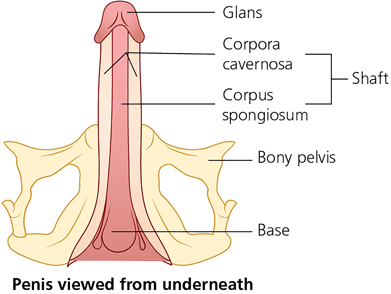Introduction.
Reproduction is the ability of an individual to produce a new individual, and is considered as one of vital signs of living organisms,
Human life starts when a male gamete called “Sperm” fuses with a female gamete called “Ovum” to form a single cell called “Zygote”.
Male and female reproductive organs are called “Gonads” they are responsible for production of sex hormones and gametes.
The medical specialty which deals with the male reproductive system and urological problems found only in men is called “Andrology”.
Male reproductive system
Penis:
The penis is the male organ of copulation (sexual intercourse).
It is flaccid for non-sexual actions, such as urination, and turgid and rod-like with sexual arousal.
When erect, the stiffness of the organ allows it to penetrate into the vagina and deposit semen into the female reproductive tract.
Penis consists of
The body of the penis is made up of three cylindrical masses of erectile tissue.
The two lateral masses are called the corpora cavernosa.
The corpora cavernosa is an erectile tissue, it gets filled with blood on sexual arousal to make penis rigid.
The smaller middle part which contains the urethra is called corpus spongiosum.
Corpora spongiosum is also an erectile tissue with less capabilities than corpora cavernosa. It helps keep the urethra open to pass sperm during intercourse.
The lower end of the corpus spongiosum is slightly enlarged, called the glans penis.
The glans penis is covered with the folded skin called the prepuce (foreskin).
The urethra opens in the glans penis in a form of slit called “Urethral orifice”.
The root of penis is made up of,
An erection and the enlargement of penis are maintained by parasympathetic division of the spinal cord.

Scrotum:
It is a muscular sac covered with highly pigmented skin, present behind penis, held hanging between the legs.
Scrotum is divided into two compartments by the scrotal septum, one housing each testes.
The scrotum is supplied with two muscles,
Dartos Muscle.
Cremaster Muscle.
These muscles relax and contract as per body's temperature to keep the temperature of the testes 2 to 4 degrees lower than body temp.

Testes:
These are male gonads.
They produce male gamete “Sperm” and androgen “Testosterone.”
They are “Two” in number, oval in shape and are housed in each compartment of the scrotal sac.
Length is 4-5 cm.
They are covered with two layers of connective tissues,
Tunica albuginea also distributes parts of testes in 300 to 400 compartments called “Lobules” by forming curtain-like structures called “Septa”.
Each lobules contain “Seminiferous tubules” , the site where sperm production takes place.
Leydig cells, also known as interstitial cells of Leydig, are found adjacent to the seminiferous tubules in the testicle. They produce testosterone in the presence of luteinizing hormone (LH).
The process of sperm production is called “Spermatogenesis.”
Spermatogenesis starts from the basement membrane of seminiferous tubules resulting in maturation of Germ cells to sperm.
In between the developing Germ cells there are some elongated cells called “Sertoli cells” that form a protective”Blood-testis barrier” and also control sperm production by forming a hormone called “Inhibin'.
The formed sperms are then stored in a structure adjoining testes called “Epididymis”, which acts as a “Storage and maturation site of sperms”
During ejaculation the sperm are transferred from epididymis to vas deferens (ductus deferens).

Vas deferens:
There are two vasa deferentia.
Also called “ductus deferens”
They are thick muscular tubes arising from the epididymis and go through the “Inguinal canal” into the pelvic cavity.
They can be accessed in the scrotum as they form a part of the “Spermatic cord”; they can be cut to prevent the transfer of sperm into the semen.
The surgical removal of small parts of vas deferens is called a “Vasectomy” and is a “Permanent Sterilization method” for males.

Seminal Vesicle:
These are slender glandular structures present on either side of the prostate gland.
The seminal vesicle along with the ampulla of vas deferens forms a structure called “ejaculatory duct” where sperms coming from vas deferens mix with secretion of seminal vesicles.
Seminal vesicle’s secretion forms 60% of the bulk of Semen (A thick milky white liquid ejaculated by male during sexual intercourse).
Secretion of seminal vesicles is rich in fructose which is utilized by sperm as an energy source for travel in the female reproductive system.

Prostate Gland:
It is a walnut shaped gland located at the base of the urinary bladder.
The prostate glands surround a part of urethra called “prostate urethra”.
The ejaculatory ducts carrying semen join the urethra in the prostate gland.
Prostate glands secrete an alkaline secretion which is essential for,
Neutralizing the acidity of urethra to protect sperm.
Coagulating and decoagulating the semen in the female reproductive system (This provides time for the sperm to utilize fructose in semen for further movement).

Bulbourethral Glands:
Also called “Cowper’s Glands”.
They are situated at the base of the penis and joined to the urethra.
They secrete a thick salty secretion that neutralizes the acidic environment of urethra present in penis called “Penile Urethra” and in the female vagina.
The secretions are secreted just before the ejaculation and also called pre-ejaculate, it doesn't contain sperm but may carry sperm present in urethra.

Commonly Asked Questions.
With a well labelled diagram, discuss Male Reproductive System.
Draw a well labelled diagram of Male Reproductive System.
With a well labelled diagram describe structure of testes.
Labels: Human Anatomy and Physiology

